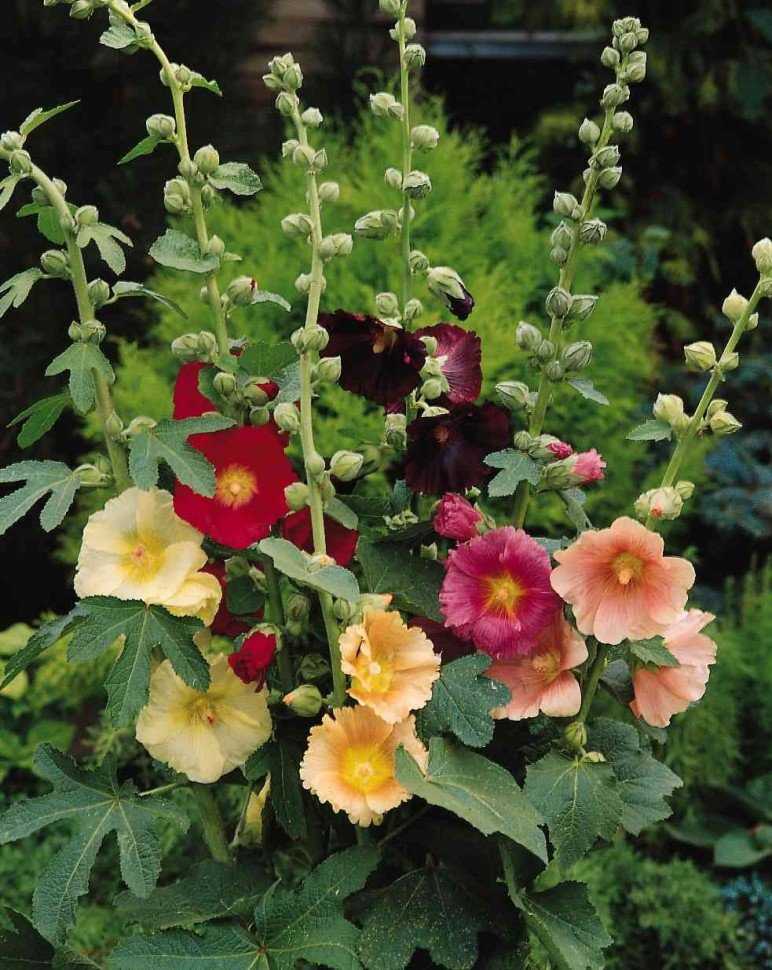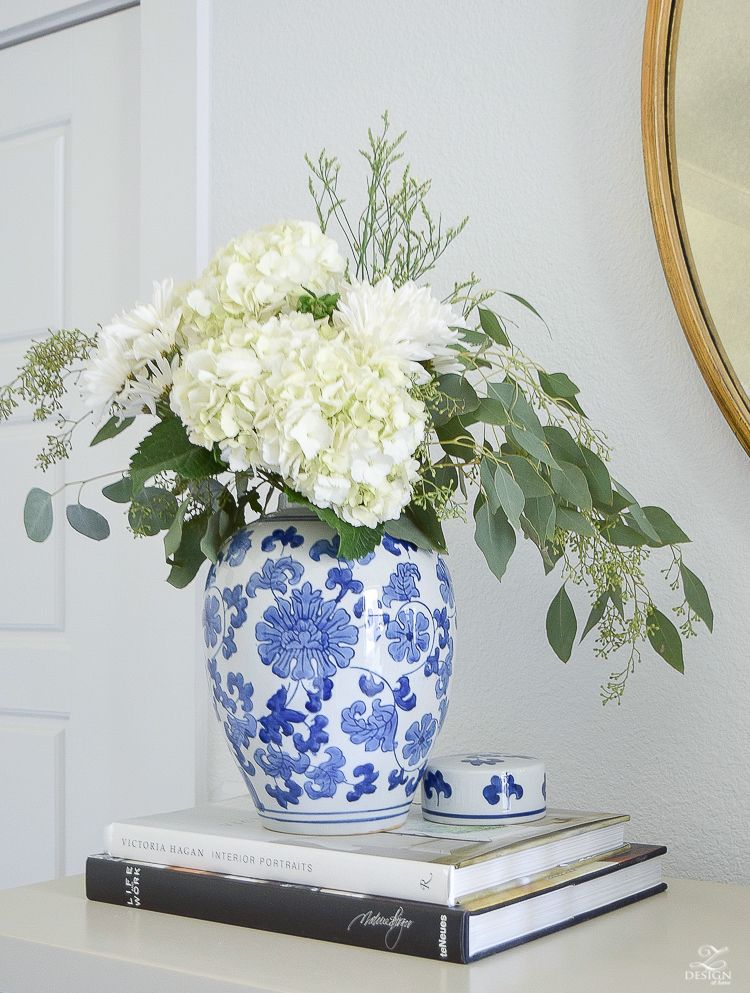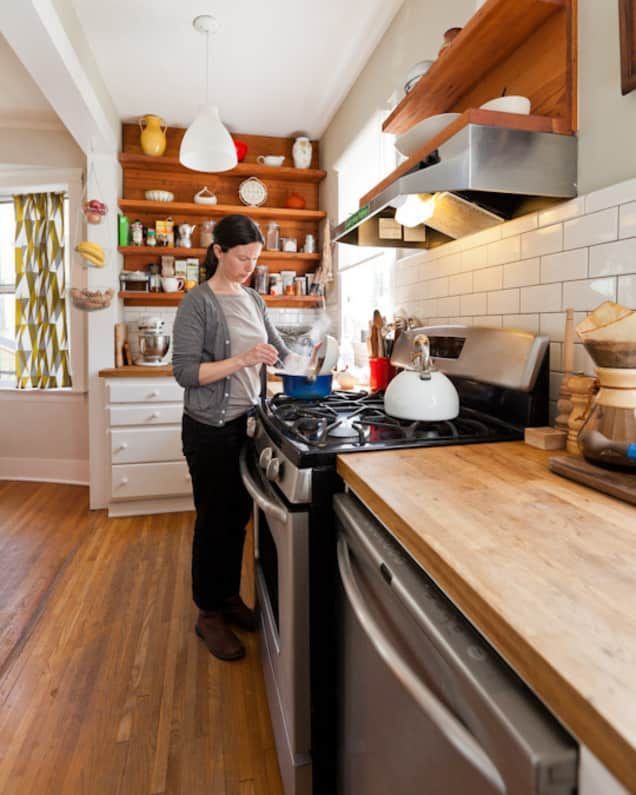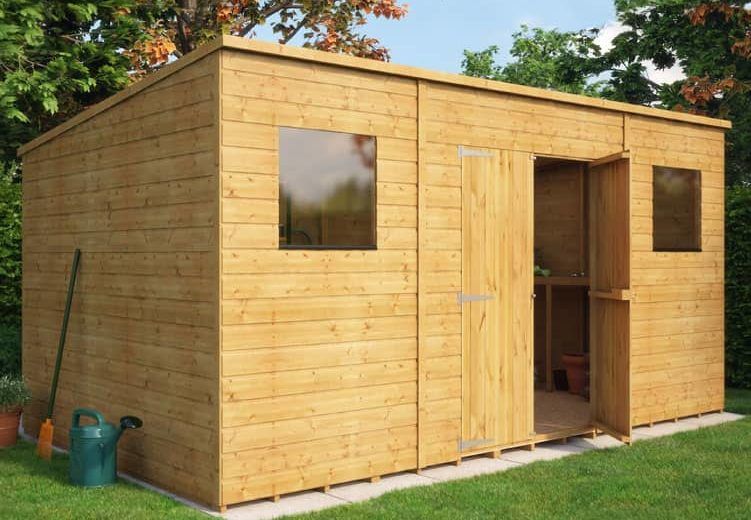Planting hollyhock seeds in the fall
for a spectacular show |
(Image credit: Getty Images)
To create the traditional look of an English cottage garden, knowing when to plant hollyhock seeds is a must.
With its charming funnel-shaped flowers – which can be pink, red, purple, yellow, or white – blooming on tall stems that soar to 6ft (1.8m) or more in summer, hollyhocks (Alcea rosea) are an impressive sight. What’s more, the single-flowered varieties provide food for pollinators, such as bees, and pair well with foxgloves, bellflowers, and lupins.
Our guide has all you need to know about when to plant these backyard beauties to fulfill your flower bed ideas and enjoy their height and color in summer and early fall.
(Image credit: Thompson & Morgan)
When to plant hollyhock seeds
Hollyhocks are best grown as biennials in order to reduce their susceptibility to a fungal disease called rust.
‘From my perspective, hollyhocks are now classified as short-lived perennials that are often grown as biennials,’ says Jonathan Sheppard , who holds the UK national collection of hollyhocks. ‘This means they produce flowers in their second year.’
Alcalthaea are fantastic short-lived perennials that are closely related to hollyhocks and well worth trying in the garden, too.
This is the inside track on when to plant hollyhock seeds as well as alcalthaea.
(Image credit: Getty Images)
Plant hollyhock seeds in spring
Hollyhocks are easy to grow from seed. As for when to plant hollyhock seeds, they can be sown under cover in March, April, or May or sown direct into soil outside in May, June, or July. Being biennial, they won’t bloom until next year.
‘When sown indoors in spring, barely cover the seed with soil,’ advises Kelly Funk, President of Park Seed , ‘while maintaining a temperature of 70°F (21°C). Germination takes 10 to 14 days. ’If your greenhouse doesn’t get that hot, 60°F (15°C) is fine and can be achieved by using a propagator.’
‘I do a sowing of hollyhocks around April,’ says Jonathan Sheppard, ‘so the plants then establish themselves and get planted out, but won’t flower until the following year.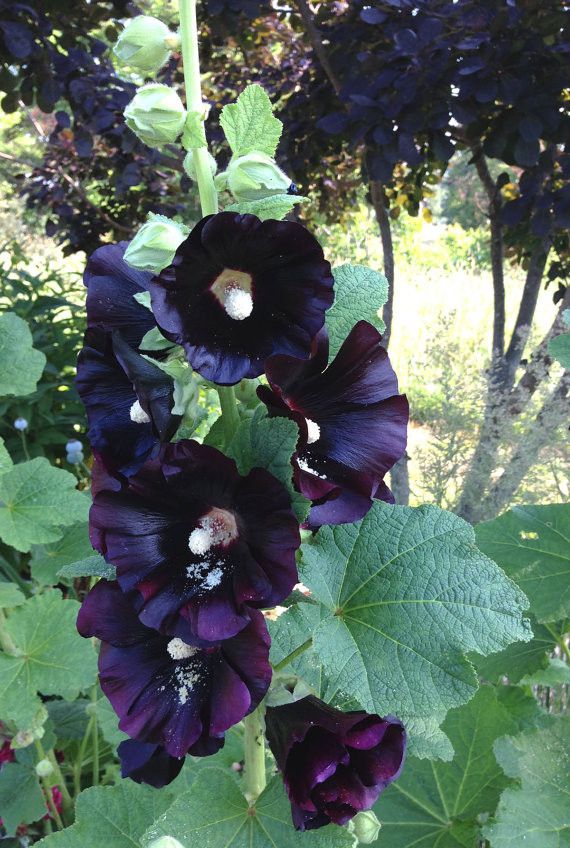 ’
’
The seeds are fairly large and are best sown into module trays: sowing one seed per module.
Plant hollyhock seeds in fall
It’s also possible to plant hollyhock seeds in late summer or fall. ‘I often do a sowing under cover around September,’ says Jonathan Sheppard. ‘This is essentially to try to cheat that biennial nature and get flowers within 12 months. I sow in 3in (7cm) pots, so that the hollyhocks have a much better chance of flowering in their first summer, after they get planted out the following year.’
The subsequent young seedlings in pots can be overwintered in a cold greenhouse or cold frame or on a cold windowsill.
Plant hollyhock seeds two years running
Hollyhocks readily self-sow, providing you with free plants (if you don’t deadhead them). However, being biennial, you must do a second sowing next year in order to ensure flowers every year (rather than flowers every other year). If you grow foxgloves, this is the same two year principle.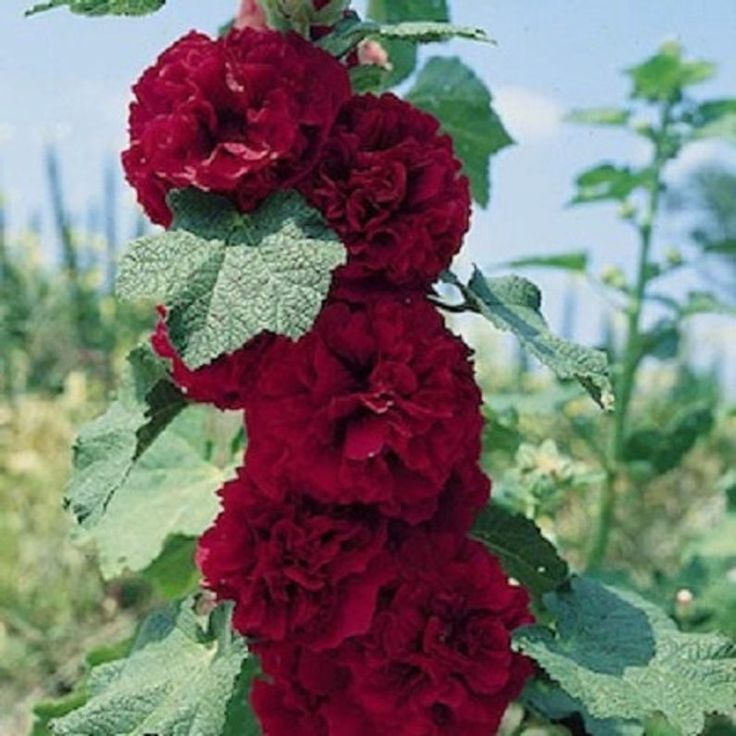
During spring or fall, the seedlings that the plants have sown themselves around the backyard can be moved into the position you’d like them to grow.
There is a huge range of hollyhocks available to sow. Some of Jonathan Sheppard’s favorites include ‘Mars Magic’ (‘a vibrant red variety that really pops in the garden’), ‘Halo Lavender’ (‘a rich purple colored hollyhock with a light center’), and ‘Peaches ’n' Dreams’ (‘a double variety whose blooms can rival those from growing peonies.’)
When to plant potted hollyhocks
Hollyhocks can be bought ready-grown in pots. Check with your supplier whether they are this year’s young plants or last year’s plants. If they were sown this year, they can be planted out between May and October and will bloom next year. But if they were sown last year, they can be planted out between April and June and should flower this summer. Plant them in well-drained soil in sheltered sun.
If you are planting a cottage garden border, buy a mix of ready-grown hollyhocks that includes a good range of colors, such as cream, yellow, pink, and purple.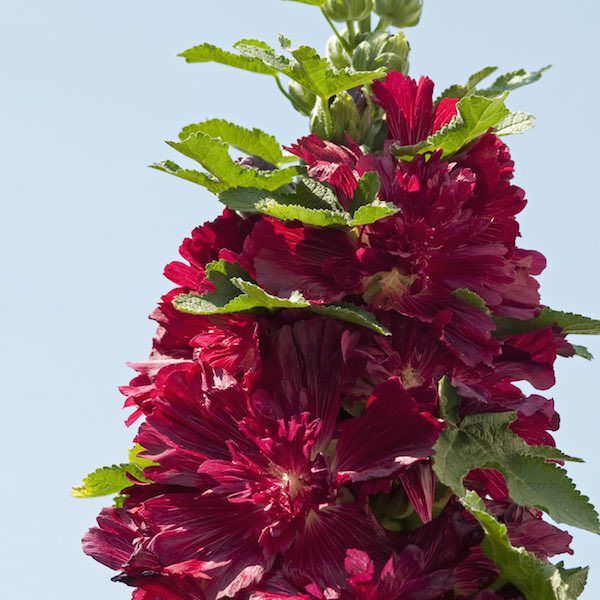 Alternatively, in a modern garden, opt for the rich claret ‘Nigra’, which looks black from a distance, or plant a mass of elegant pale cultivars (such as ‘Halo White’).
Alternatively, in a modern garden, opt for the rich claret ‘Nigra’, which looks black from a distance, or plant a mass of elegant pale cultivars (such as ‘Halo White’).
When to plant plug plant hollyhocks
Sometimes hollyhocks are available in nurseries as trays of tiny plug plants. These should be transplanted into bigger pots and left until they reach a big enough size to plant outside between April and October. Plant them in well-drained soil in sheltered sun.
When to plant alcalthaea
Alcalthaea are the gorgeous offspring of hollyhock (Alcea) and marshmallow (Althaea). Bred for flower power and reduced susceptibility to rust (a fungal disease that can plague hollyhocks), they are a triumph. Being healthier, these perennials live a lot longer than common hollyhocks and produce wider, branching plants that form a goblet shape. Capable of 8ft (2.4m), they bloom for a long time: sometimes from July into October, making them a great addition to the border.
Buy alcalthaeas, such as beautiful ‘Parkallee’, as ready-grown pot plants and plant them in well-drained borders in sun during spring or early summer or in the fall.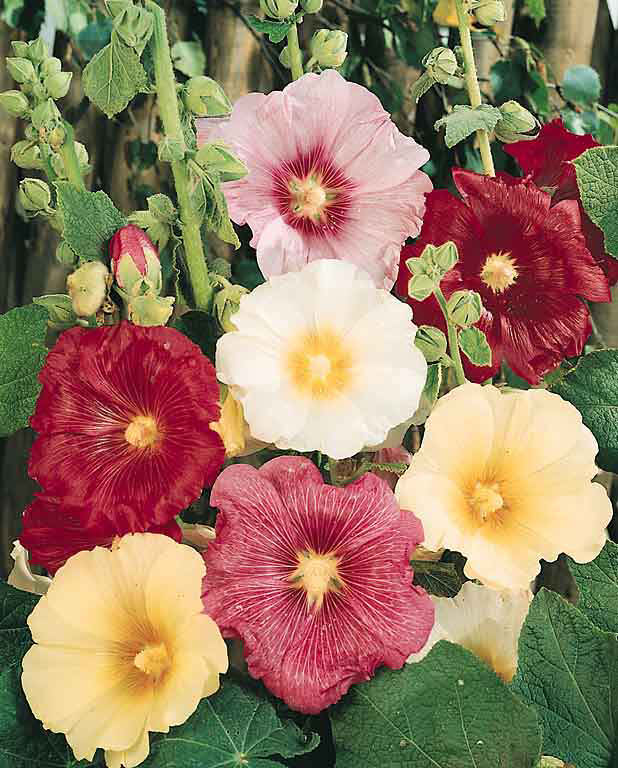
How long does it take for hollyhock seeds to sprout?
Hollyhocks take around 10 to 14 days to germinate and then it’s another three to four weeks before they are ready for pricking out. Make sure that hollyhock seeds aren’t planted too deeply if you’re sowing them indoors in spring. The barest covering of soil is necessary.
Do hollyhocks flower in the first year?
Hollyhocks don’t flower in the first year. This is because they are biennials, establishing their roots and foliage in the first year and producing flowers in their second year. For flowers every year, plant hollyhock seeds two years running.
Lucy Searle has written about interiors, property and gardens since 1990, working her way around the interiors departments of women's magazines before switching to interiors-only titles in the mid-nineties. She was Associate Editor on Ideal Home, and Launch Editor of 4Homes magazine, before moving into digital in 2007, launching Channel 4's flagship website, Channel4. com/4homes. In 2018, Lucy took on the role of Global Editor in Chief for Realhomes.com, taking the site from a small magazine add-on to a global success. She was asked to repeat that success at Homes & Gardens, where she has also taken on the editorship of the magazine.
com/4homes. In 2018, Lucy took on the role of Global Editor in Chief for Realhomes.com, taking the site from a small magazine add-on to a global success. She was asked to repeat that success at Homes & Gardens, where she has also taken on the editorship of the magazine.
When To Plant Hollyhock Seeds For Bright Blooms
Table of Contents
Hollyhocks, scientifically known as Alcea rosea, are gorgeous, eye-catching plants that will draw in pollinators of all kinds. Many people are discouraged from growing hollyhock flowers because they’re biennial and won’t grow flowers the first year. If you don’t mind waiting, they’re pretty easy to grow! The key is knowing when to plant hollyhock seeds.
Growing hollyhocks is well worth the wait since they develop beautiful flower stalks that will likely tower over you. They’re attractive to bees, birds, and other pollinators, so they’re an excellent choice to keep around your vegetable garden to increase food production.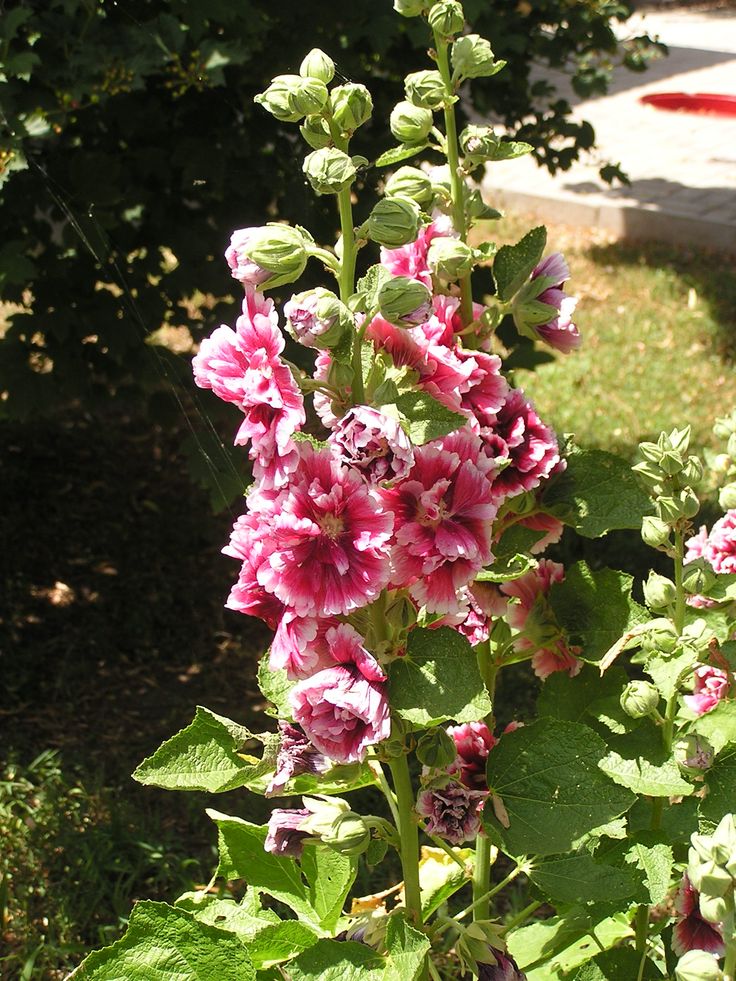
Since they grow several feet tall, they work well along fences or serve as a natural privacy hedge along property lines. You may need to give your flowers stakes to protect them from damaging winds if you live in a windy area.
Let’s take a look at when to plant hollyhock seed so you can add these wonderful flowers to your garden.
All About Hollyhocks
Determining when to start hollyhock seeds is important. Source: Chiot’s RunAlcea rosea is a stunning yet elegant flower to have in your garden. They’re a classic cottage garden staple because of their pastel hues and delicate look, and you’ll probably find growing hollyhock flowers in a grandmother’s garden.
Although they look delicate, they’re actually a hardy plant. They’re recommended to be planted in USDA hardiness zones 3-8, but they can sometimes be grown in zones 2, 9, and 10 if they’re given special care. If you have harsh winters, plant them in a container and bring them indoors to protect them.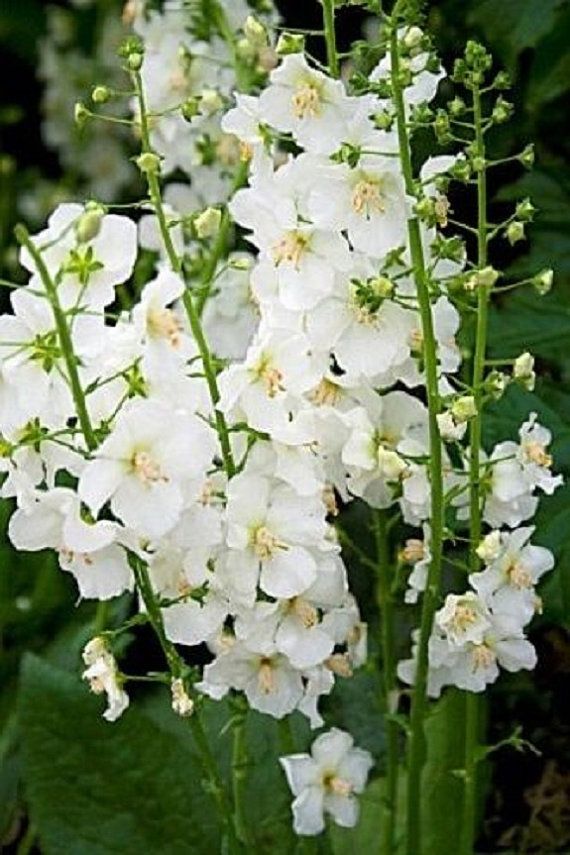 If you have harsh summers, choosing an area that receives midday shade will help them.
If you have harsh summers, choosing an area that receives midday shade will help them.
Hollyhocks are biennial, meaning that they take two years to complete their life cycle, so you won’t see any hollyhock flowers the first year you plant hollyhocks. This discourages many gardeners since many popular flowers are annuals or perennials that develop flowers the same year they’re planted. The lack of flowers doesn’t mean they won’t show up; you’ll just have to wait until next year.
It’s worth the wait! While the first year may not look as gorgeous as you imagined, the second year certainly will. Most hollyhocks are at least 5 feet tall (1.5 meters) and can reach up to 8 feet (2.4 meters). The top portion of the stem will be covered in clusters of flowers in a rainbow of warm colors.
Hollyhocks are called short-lived perennials because they typically only live two or three years, meaning you’ll only see them bloom once or twice. But prune the stalks once the hollyhock flowers start to die, and they’ll grow back the following year.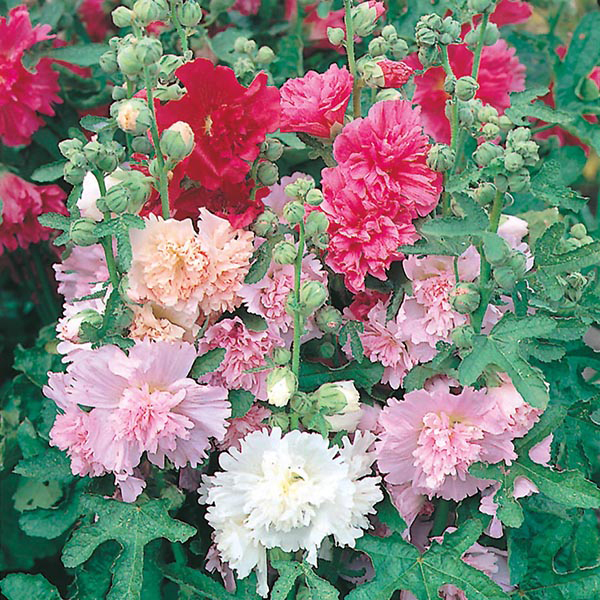 You can extend their lifespan by several years with this practice.
You can extend their lifespan by several years with this practice.
You can easily get hollyhock blooms each year in the cottage garden since the flowers will readily self-seed by dropping their seeds. If you allow the seeds to drop and grow freely, you’ll see new stalks shoot up each year, and you’ll always have continual blooms.
If you don’t want them to reseed, you’ll need to remove spent blooms to prevent seed heads from hitting the ground. Removing the blooms is also how you can save hollyhock seeds so you can plant them elsewhere.
When to Plant Hollyhocks
A hollyhock seed pod, dried and ready to drop seed. Source: camerashakeHollyhock plants typically bloom in the middle of summer and early fall, so choosing when to plant them is important. You won’t see blooms during their first year, but allowing them plenty of growing time will guarantee that you see them next year.
Planting Seeds Outdoors
Hollyhock seeds can take up to three weeks to germinate, so they should be started pretty early in the season to make sure they have plenty of time to grow during their first year.
If you want to plant seeds directly in the ground in the spring, you should plant them one week before the last frost date. Keep a close eye on the weather forecast so you don’t accidentally plant too soon, as the cold temperatures may prevent germination. Spring planting is recommended for those who have severely cold winters.
If you live in a warm climate with a long growing season and mild winters, you may prefer to sow seeds in late summer. Doing so may allow you to have beautiful flowers the following summer if the plants have enough warm days and sun to grow.
You can also plant seeds in containers if you wish to do so. You may be able to extend the growing season since you’ll be able to move the container around as needed to provide the seeds with more sun or warmth as the weather changes each season.
Planting Seeds Indoors
Starting hollyhocks indoors will allow you to grow the plants outside of the typical time frame, allowing you to get a bit of a head start. Plant the seeds in individual pots or cells and use grow lights to provide them with full sun.
Plant the seeds in individual pots or cells and use grow lights to provide them with full sun.
You should start seeds indoors in seed-starting cell trays a couple of months before the ideal time to plant transplants, which we’ll talk about next. For a spring transplant, you’ll need to plant seeds in late winter or early spring. For a fall transplant, planting seeds mid-to-late summer should be enough time.
Keep in mind that seeds grown indoors and outdoors will have different times of the year to plant, so you likely won’t get to plant them both at the same time.
Planting Transplants Outdoors
Hollyhock seedlings are usually ready to transplant outside into cottage gardens about nine weeks after planting the seeds. Fall is the best time of year to move the seedlings. You can attempt to transplant hollyhocks in the spring, but they may not fare well due to the possibility of a spring freeze.
If you’re unsure about when to move your hollyhock plants, check reputable local plant nurseries.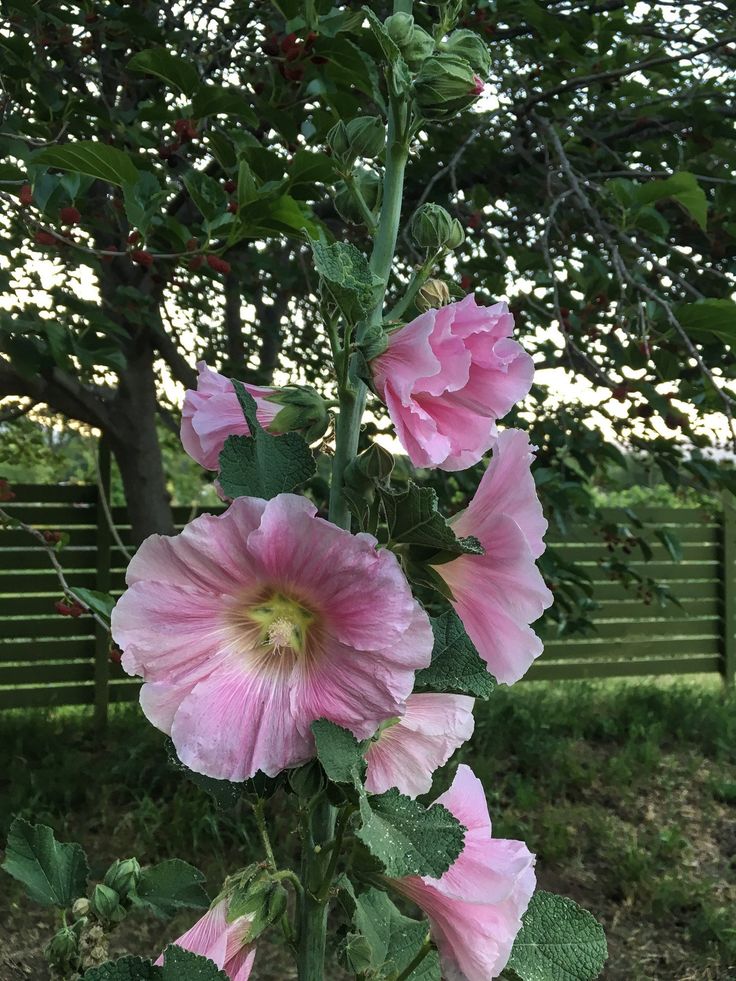 If they have young hollyhock plants for sale, it’s the right time to move them.
If they have young hollyhock plants for sale, it’s the right time to move them.
How to Plant Hollyhocks
You’ll need to start seeds well in advance. Source: hello-julieKnowing when to plant hollyhocks is the first step toward getting them in your garden. Now, let’s talk about how to do it.
Soil
You can plant hollyhocks in almost any type of soil since they’re not picky. They’re happy with clay, loam, or sandy soils. However, to give your seeds the best chance of survival, you should choose a fertile soil or seed starting mix. The pH of the soil should be between 6.0 and 8.0 for the best results.
You can use a potting mix for hollyhocks you want to grow in containers. For the flowers growing in the ground, apply compost or fertilizer in the spring.
Hollyhocks don’t like soggy soil, so make sure you choose well-drained soil so the water can’t form puddles.
Water
New plants need more water than mature ones, so you’ll need to keep your seeds and seedlings moist.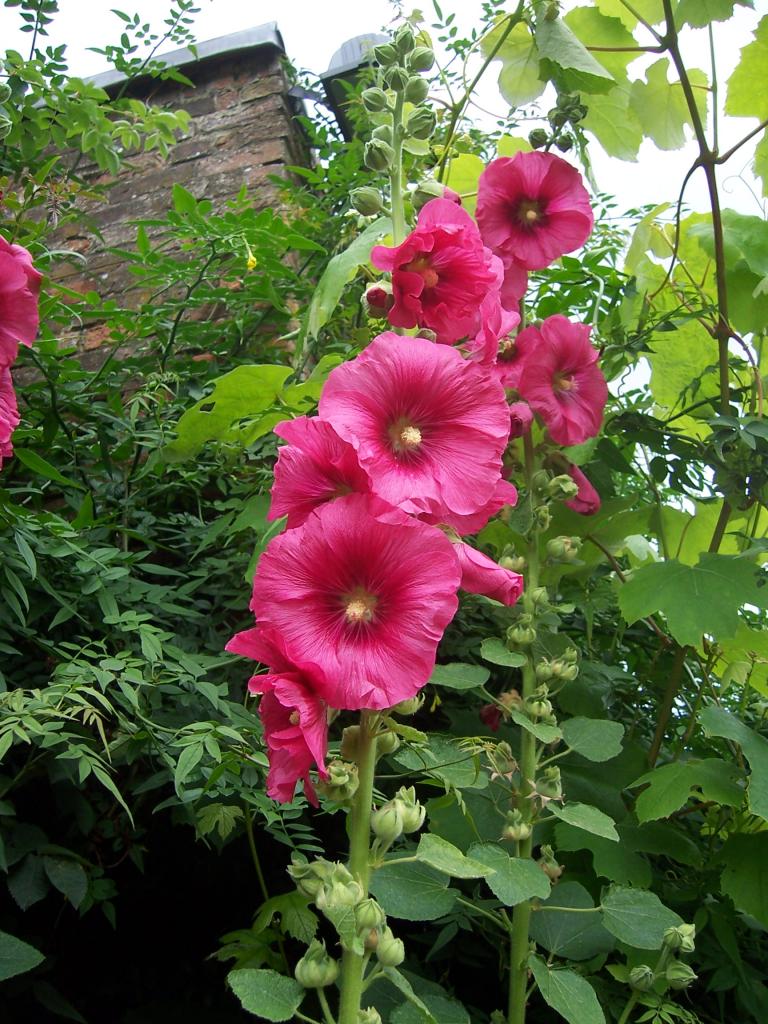 Don’t allow puddles to form or the soil to dry out while your flowers are young. They can tolerate frequent watering if you choose well-drained soil. If you’re growing seeds indoors, make sure the containers have drainage holes in the bottom.
Don’t allow puddles to form or the soil to dry out while your flowers are young. They can tolerate frequent watering if you choose well-drained soil. If you’re growing seeds indoors, make sure the containers have drainage holes in the bottom.
Avoid getting the leaves wet when you water. Hollyhocks are prone to rust disease, which is a fungal infection that can damage your hollyhocks. Making sure that water only touches the soil is an important step to prevent rust disease.
Transplanted hollyhock flowers also need more water than usual for one or two months after being transplanted. Aim to give the plants about one inch of water per week. Once the plants are established in their new home, you can water less frequently.
Mature hollyhocks are somewhat tolerant of dry soil, so if you have to skip watering for a few days or your area is going through a dry spell, they should survive a while with less water than usual.
Sunlight
Hollyhocks are happiest when they receive full sun, which is six or more hours of direct sunlight.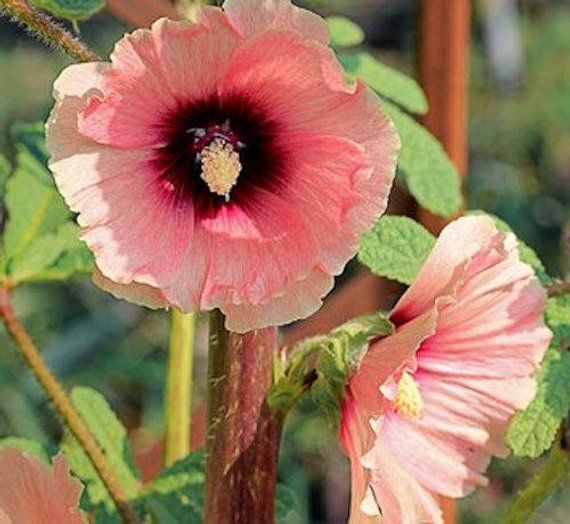 They can tolerate partial shade, but in most cases, you’ll see them at their best when they have sufficient sunlight and water.
They can tolerate partial shade, but in most cases, you’ll see them at their best when they have sufficient sunlight and water.
One situation where your flowers might need partial shade is if you live in an area that receives excessive heat in the summer. Having shade during the heat of the day will protect the flowers and leaves from burning. The shade can come from a tree or building or you can cover them yourself with a row cover.
If you do decide to protect your hollyhocks from the heat, remember that they need at least six hours of sunlight.
Planting
This shows off hollyhock seeds, albeit in black and white. Source: jlevingerTo plant the seeds outdoors, prepare the soil with a rake, so it’s not compacted. Scatter the seed evenly across the area if you want a flower bed full of them. Covering the seeds with soil isn’t necessary and they shouldn’t be any deeper than ¼ an inch below the soil. You can lightly cover them with a thin layer of soil if you’d like.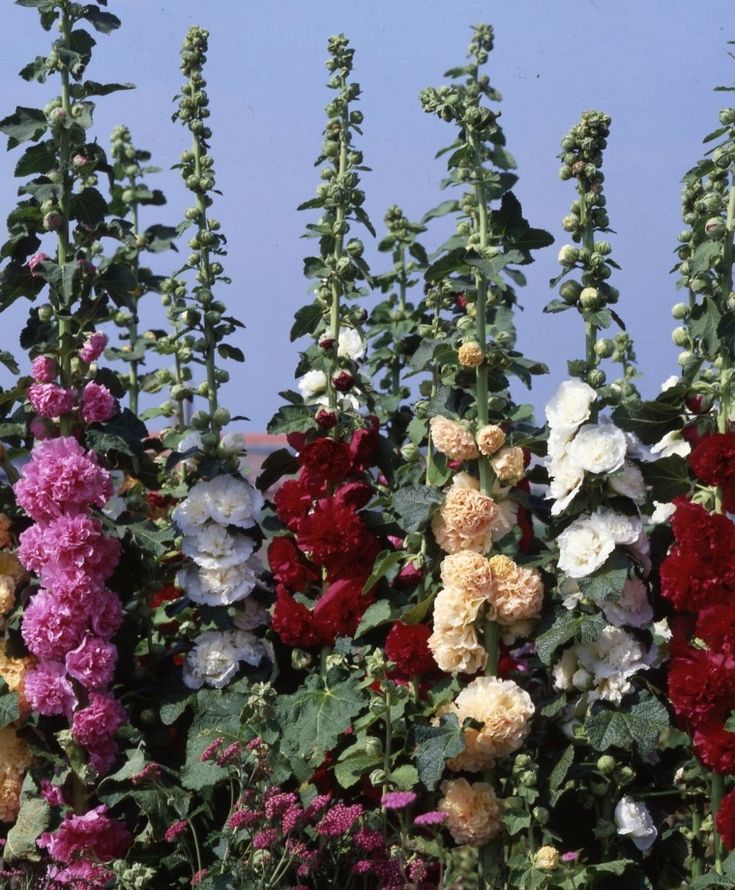 If you live in a windy area or have a lot of birds, covering them may be safer.
If you live in a windy area or have a lot of birds, covering them may be safer.
To plant seeds indoors or intentionally in the ground, plant 1-3 seeds in an indention in the soil. Just as you would with scattered seeds, you can cover them with a thin layer of soil. You’ll need to thin out the seedlings once they sprout if you put more than one seed in the same spot.
Gently water your seeds, making sure that water doesn’t puddle up, and move them around. This is especially important for scattered seeds outside. Be prepared to wait a few weeks for them to germinate and keep the soil moist while you wait.
How to Transplant Hollyhocks
Transplanting hollyhocks needs to be done carefully, so you don’t accidentally damage the plant.
Begin by thoroughly watering the hollyhock the day before you transplant it so the plant will be well-watered. Dig a hole that’s the same depth as the root ball but is twice as wide. Carefully place the seedling in the hole and fill it up with soil.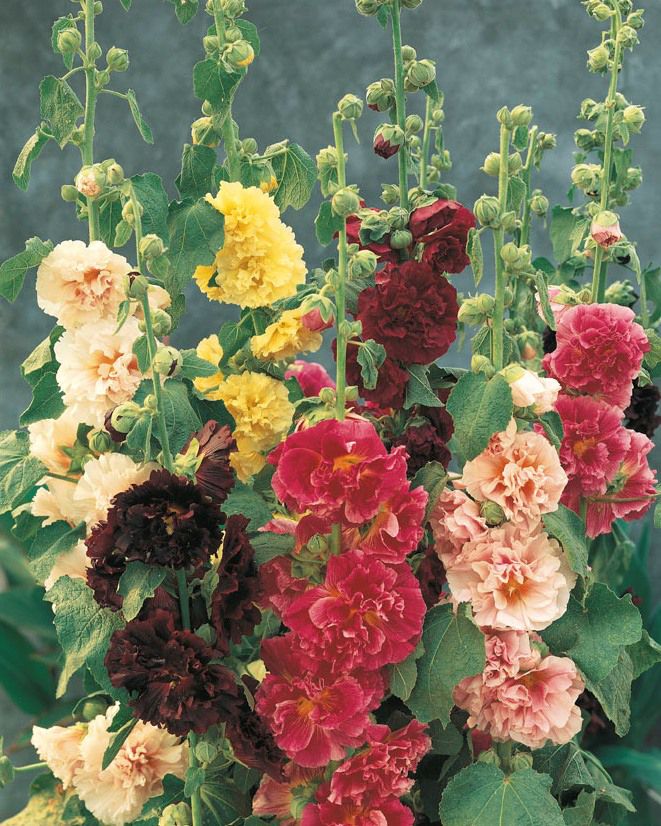 Water it thoroughly to allow the soil to settle. If needed, add more soil.
Water it thoroughly to allow the soil to settle. If needed, add more soil.
The top of the root ball should be at the same level as the soil line, so your hollyhock shouldn’t be sunken in or sitting on a little hill.
Frequently Asked Questions
Seed pods forming along a hollyhock stem. Source: cogdogblogQ: Are hollyhocks easy to grow from seed?
A: Hollyhocks are easy to grow from seed if you give them full sun and enough water. They will require some patience since you won’t see any flowering until the second year.
Q: Can you just scatter hollyhock seeds?
A: Yes, you can scatter hollyhock seeds. You don’t have to cover them with soil if there isn’t much risk of wind or birds getting to them.
Q: How long do hollyhocks take to grow from seed?
A: Hollyhocks can take up to three weeks to germinate, and they won’t begin flowering until the second year. If you allow hollyhocks to reseed, you’ll eventually get beautiful blooms each year.
Planting mallow with seeds in autumn - when and how to plant in open ground
For a while mallow was forgotten a little, being carried away by "fashionable and modern" plant species and hybrids. But now, thanks to new varieties that have appeared, it is increasingly planted in gardens. In autumn, perennial mallow requires little to no care, but if you need to repot or plant it with seeds, then in this article you will learn how to do it right, with a guaranteed result.
Description of mallow How to harvest mallow seeds When to sow mallow How to plant seeds outdoors in autumn How to care for mallow in autumn How to transplant mallow in autumn Where to place mallow
Mallow is distinguished by its variety of varieties. Photo
Description of mallow (stock rose)
The official name of the plant is stock rose. Translated from German: "stick with roses." In the people, the plant is most often called mallow. It is this option that we will use in the article.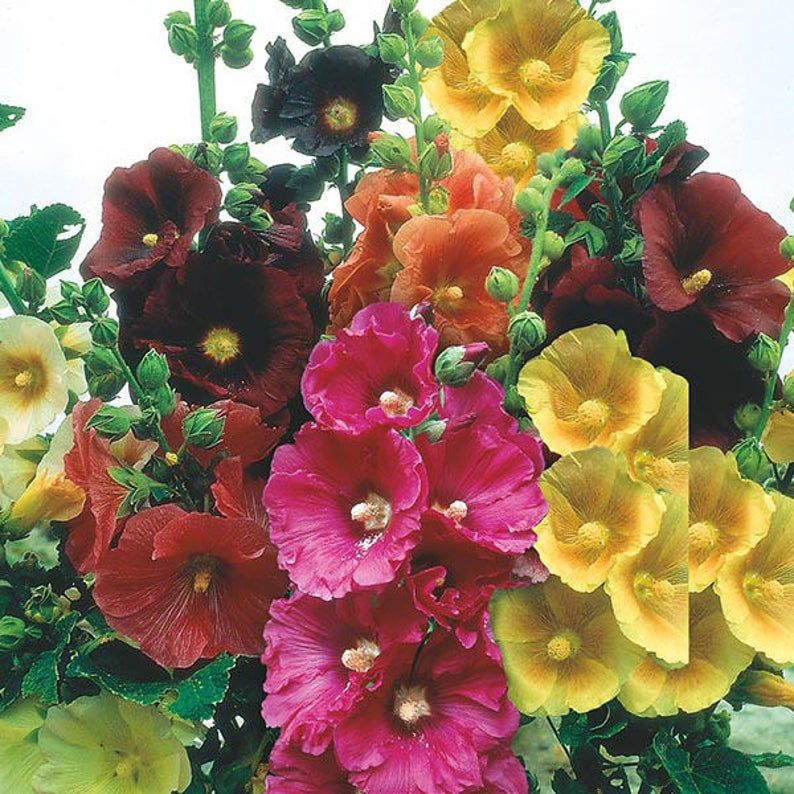
Commercial seed bags indicate that mallow is a biennial plant. Based on the practice of growing, mallow can be called a perennial. Of course, the strongest and most violent flowering of the plant occurs in the second year of life, but the following summer, its flowering fascinates and attracts the eye.
Important
Cut off all flower stalks at the root immediately after flowering so that your mallow becomes a perennial.
Variety of shades and colors of mallow inflorescences is great. Photo
There are many types of mallow, but the tall mallow and its hybrids are most often cultivated. It reaches a height of 2.5 meters.
Flowering starts in July and lasts until September. The plant has large flowers that bloom alternately, starting from the middle of the stem, heading towards the top. Flower diameter 12 cm. Flowers are simple and double. There is a wide variety of colors and shades. The bush can be with pink, white, yellow, beige, burgundy, lilac, lilac, pale ocher flowers.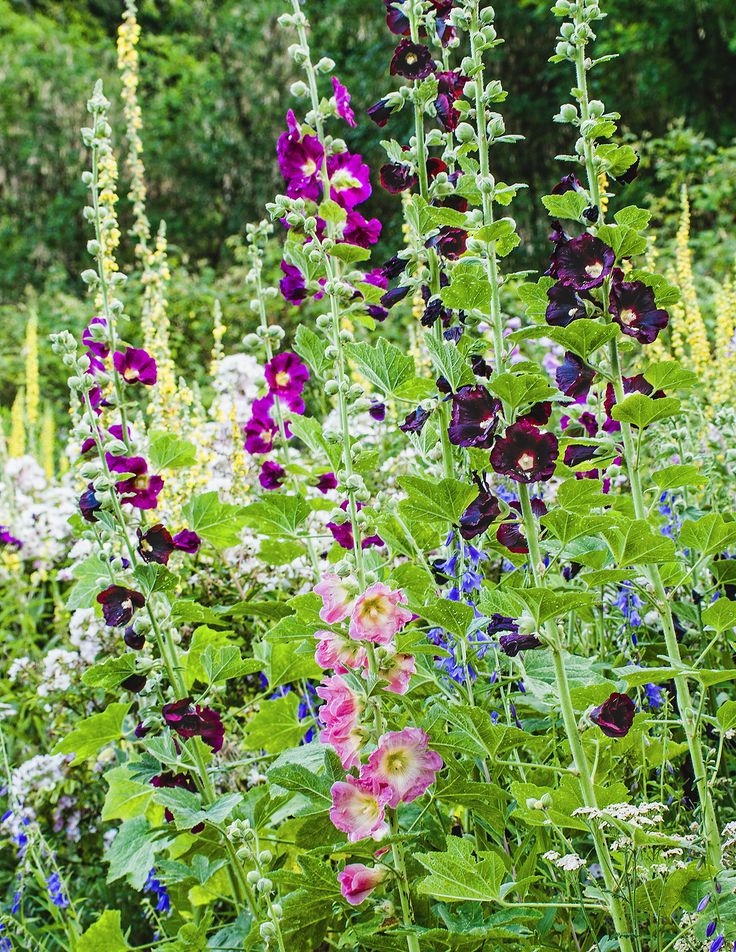 All shades can not be counted.
All shades can not be counted.
Notes
Flowering occurs in the second year after planting.
Malva is a medicinal plant, medicinal properties are similar to the closest relative Althea officinalis. But mallow is a little weaker.
High mallow.
When and how to collect perennial mallow seeds
Mallow flowers cross-pollinate. When collecting seeds from a plant of the same color, you can get hybrid seeds with other colors and shades. It will be a pleasant surprise every time.
Notes
Seeds ripen gradually due to the fact that flowering is not uniform, it goes from bottom to top. We start collecting them from August and continue until September.
An easy way to tell if a seed is ripe or not is to open the dry seed pods. As soon as we notice this, then for an accurate determination we perform a few more simple manipulations. You need to rub the box in your hands. If it is dry, breaks easily, and the seeds easily spill out of it on the palm of your hand, then the time has come.
Tip
Pick them up in dry weather. It is desirable that there was no rain the day before.
Dry pods and mallow seeds Photo
Place the collected seeds in a dry, ventilated room and dry at a temperature of 25 degrees. The process takes approximately 7 to 10 days if there is no high humidity in the atmosphere. If the weather is humid, dry longer.
We clean the seeds from the remnants of the box. Seed germination persists for 2-3 years. But only freshly harvested seeds have 100% germination. Dried seeds are removed for storage or sown in the ground before winter.
How to store mallow seeds:
- Place the collected seeds in paper or cloth bags.
- Storage temperature: +8 to +12 degrees.
- The place is dark and dry.
When to plant mallow outdoors in autumn
Seeds need stratification, so it is best to sow mallow before winter. We select the time in such a way that a week (or two) remains before the onset of frost.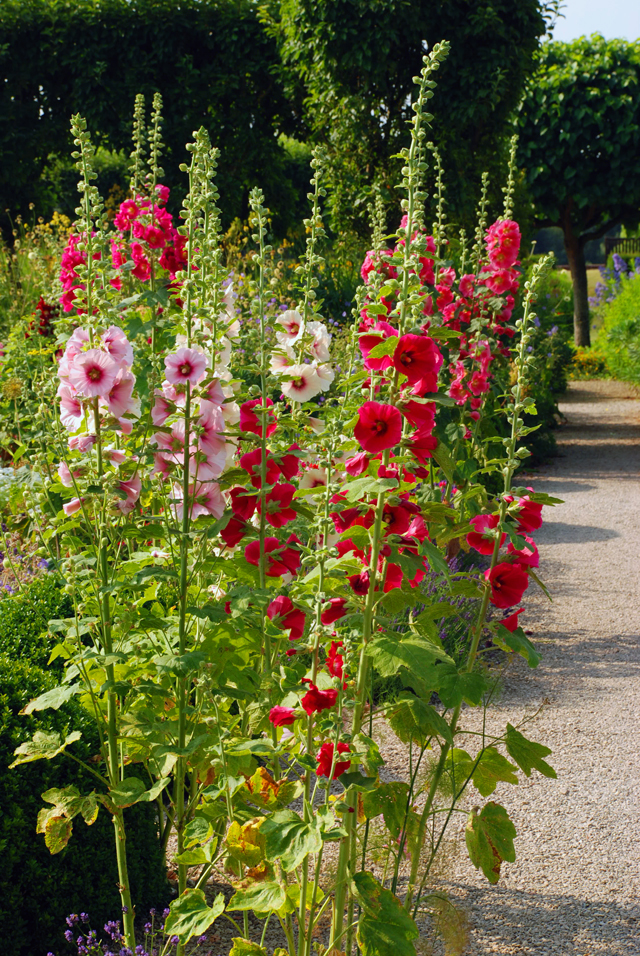
Planting mallow is best in October. Photo
Usually planted outdoors in October. Sometimes there is a warm November, so in each case we approach individually. We do not need the seeds to germinate, otherwise the seedlings will be beaten by frost.
How to plant mallow with seeds in autumn
- In the dug-up area, we make holes 2.5-3 cm deep. If you plant in a seedling bed, then you can sow the seeds much closer.
- Top the hole with fertile soil, a layer of dry foliage or peat.
- Plantings are not watered. There is a lot of precipitation in autumn.
- Mallow sprouts together in spring, but begins to bloom only in the second year.
Holes for planting mallow in autumn are placed at a distance of 40-50 cm. Photo
Caring for mallow in autumn
Proper preparation of a plant for wintering is half the success for successful cultivation.
- We continue to remove weeds near the plant, top up with mulch if necessary.
 In adult plants, we cut off faded flower stalks at the base. After pruning, some types of Malva bloom again.
In adult plants, we cut off faded flower stalks at the base. After pruning, some types of Malva bloom again. - For the winter in central Russia we do not cover adult bushes older than 2 years, the mallow is winter-hardy. If the place is open and ventilated, then it makes sense to cover it with spruce branches or cover it with leaves on top.
- The base of young bushes is abundantly mulched with humus or compost. We pour a hill right in order to insulate the roots for the winter. In the spring, we distribute this slide over the surface of the earth, around the roots of the plant. We take organics at the rate of 3 kg per 1 m 2 .
Photo: Mallow re-blooms after pruning.
On the underside of the leaves you can often see rusty dots-tubercles. It's rust. We burn such leaves, do not put them in a compost heap and do not leave them on the ground under the bushes. Rust is airborne.
Advice
If you find rust on one plant, then we treat and carry out preventive maintenance of all the bushes of the site, we treat diseased plants.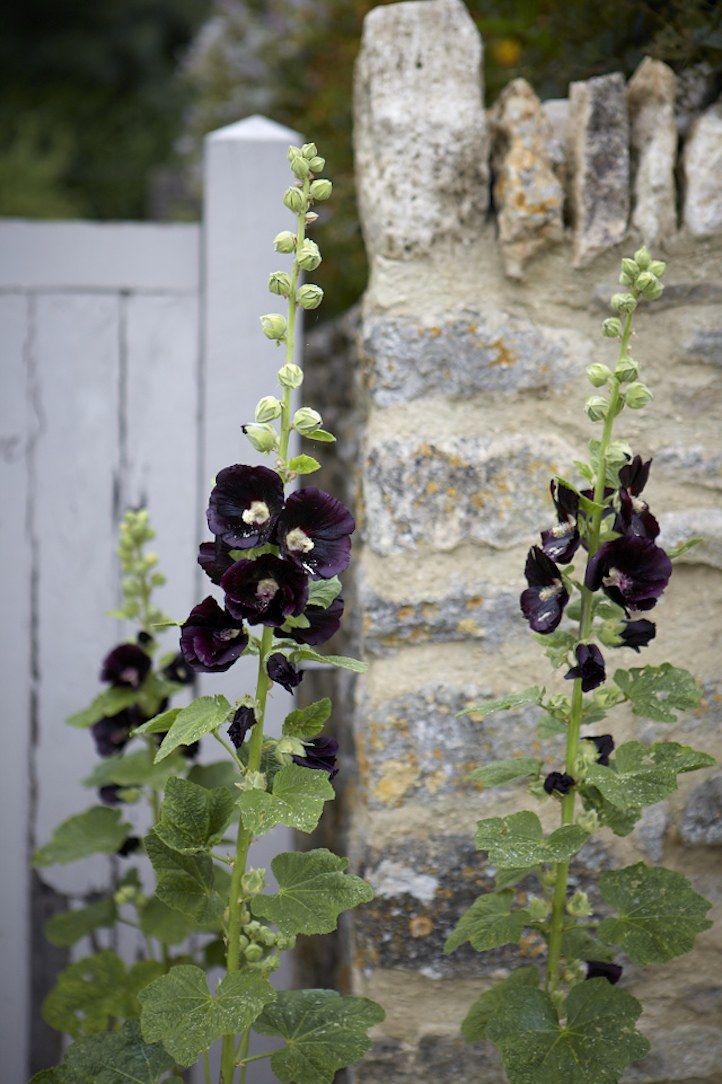
Mallow often rusts. Photo
If you have to remove all the leaves on the plant, it's okay, new ones will grow in the spring. We treat by spraying the leaves, trunk and earth around the plant. I most often use Bordeaux mixture 3%, but you can use any preparations that have a fungicidal effect.
Malva is quite often affected by rust, because of this it is not grown for a long time in one place and is not planted near metal fences.
Transplantation of mallow in autumn to a new place
Mallow is very difficult to transplant. The root system of the mallow is powerful and fleshy with many small threads-roots, which are mainly injured.
Mallow seedlings are ready for transplanting to a permanent place from late August to early September. Even if the aerial part of the plant does not look high, the root is already branched and buried. Dig up a flower only with a shovel and transplant with a clod of earth.
Mallow has a powerful and fleshy root system.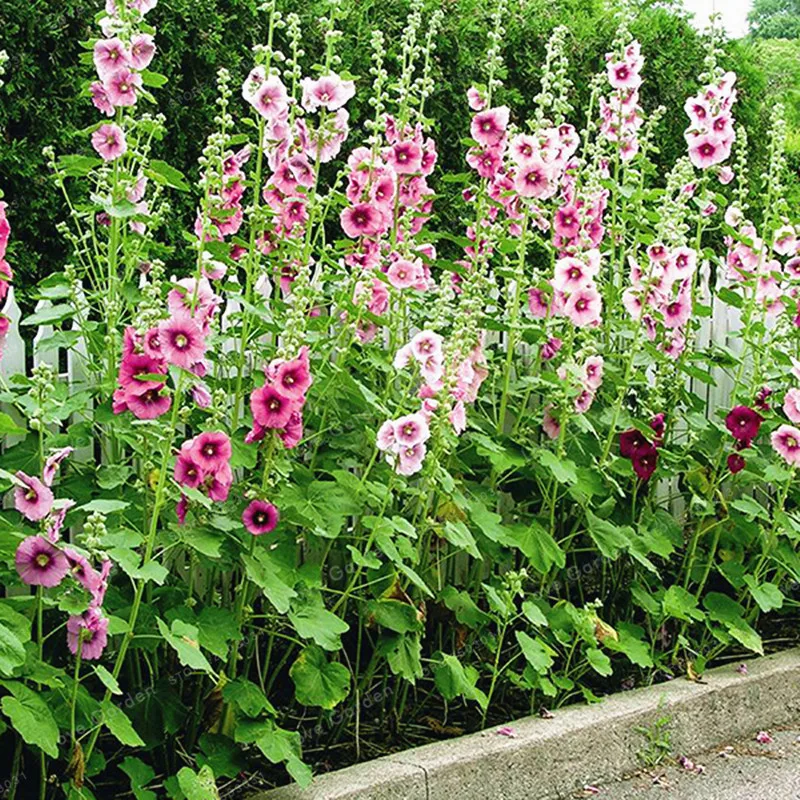 Photo
Photo
- Seedlings are planted at a distance of 50 cm from each other.
- Top with a layer of peat and dry leaves. For the winter we cover with spruce branches or straw.
If you need to transplant an adult plant to a new place, then carefully dig it out, trying not to damage the roots. Digging up an adult bush will be difficult. It is best to transplant in early September, so that the plant adapts to new conditions in the remaining time.
Where to plant mallow
Mallow can often be seen in rural and urban front gardens. This plant is chosen for its unpretentiousness during cultivation and beauty during flowering. It grows equally well both in sunny places and in partial shade. But it is best to place in a sunny place where there are no strong winds.
Wishlist
Ideal for background decoration in flower beds, mixborders near fences. An array of mallow can close an unsightly wall of a building or a technical corner in a garden.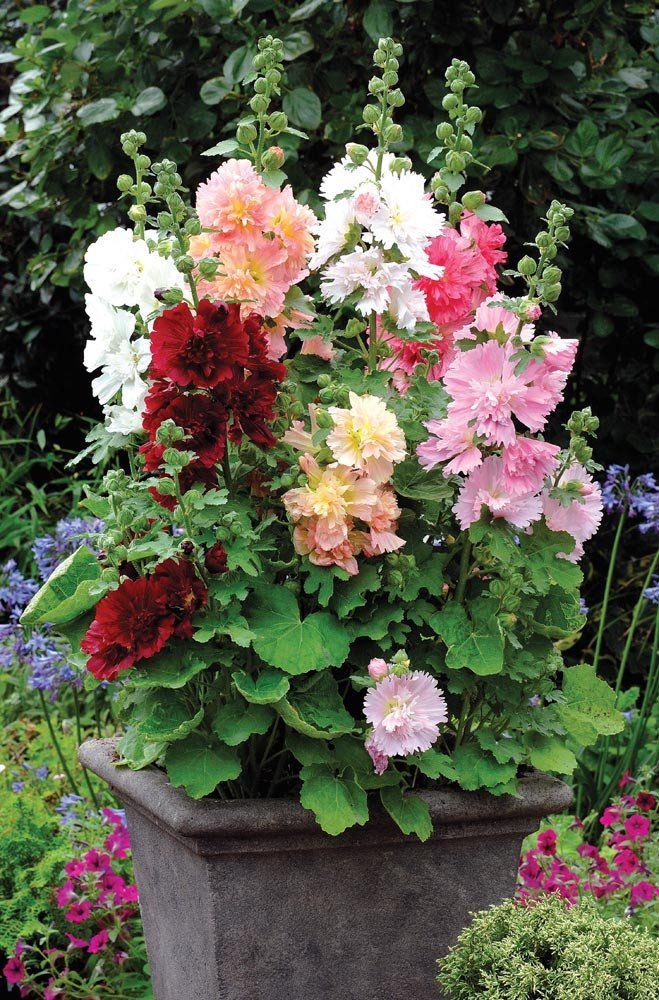
Mallow can be a good decoration for a wall. Photo
Green mallow walls can also be used to create "rooms" on the site, dividing it into the spaces we need. The advantage of such green hedges is that they are easy to remove and change the geometry of space.
Use mallow to create garden geometry. Photo
In mixborders, mallow is planted with low and medium-sized perennials to create dynamics and add color.
When choosing a site, keep in mind that the mallow grows into a large bush that can collapse over time. Therefore, provide natural support from a fence, pergola or wall. You can also tie it to a regular bamboo peg.
Is it possible to sow mallow seeds before winter
For better germination of mallow seeds, they must be stratified. Therefore, experts recommend sowing before winter so that the seed hardening process takes place in natural conditions.
Mallow is an unpretentious crop, does not require special attentionWhen is it better to plant mallow with seeds in autumn before winter
The second half of October is best for planting mallow with seeds in autumn.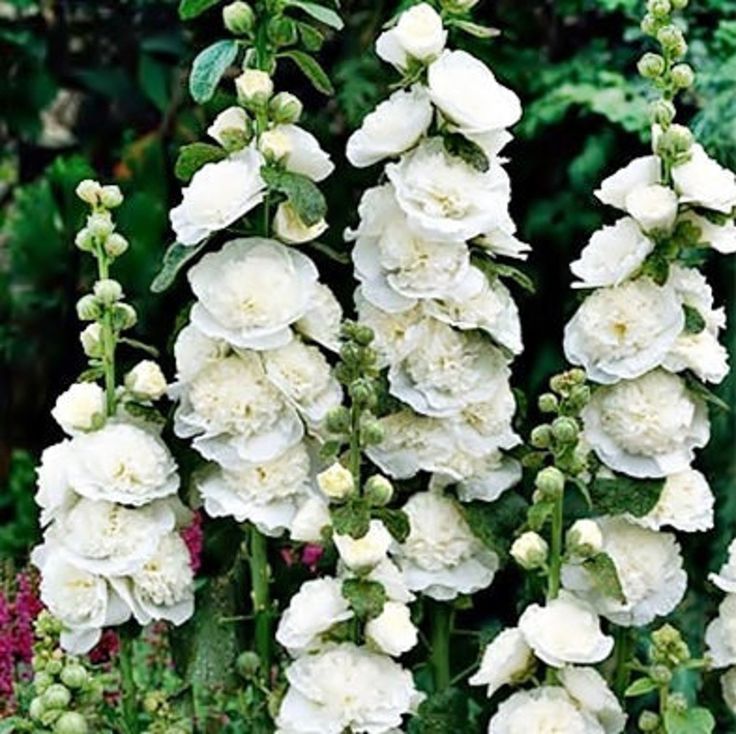 If, according to weather forecasts, there will be abnormally warm weather in November, then it is better to transfer the sowing of seeds to the first decade of the last month of autumn. The main thing is that they do not have time to germinate before the winter frosts, otherwise the seedlings will disappear.
If, according to weather forecasts, there will be abnormally warm weather in November, then it is better to transfer the sowing of seeds to the first decade of the last month of autumn. The main thing is that they do not have time to germinate before the winter frosts, otherwise the seedlings will disappear.
Planting perennial mallow with seeds in autumn in open ground
To grow a lush bush with a large number of inflorescences from seeds, sowing is carried out before winter. In this case, some subtleties of plant cultivation should be taken into account.
Site and soil requirements
When choosing a place to sow mallow seeds in the fall, choose light, fertile soil with good drainage. Sown in a lowland, where there is constant stagnation of moisture, it will gradually fade. Since the root of the plant will begin to rot.
Sowing stock-roses is carried out in sunny areas of the garden, while in winter the area should not be blown through by winds.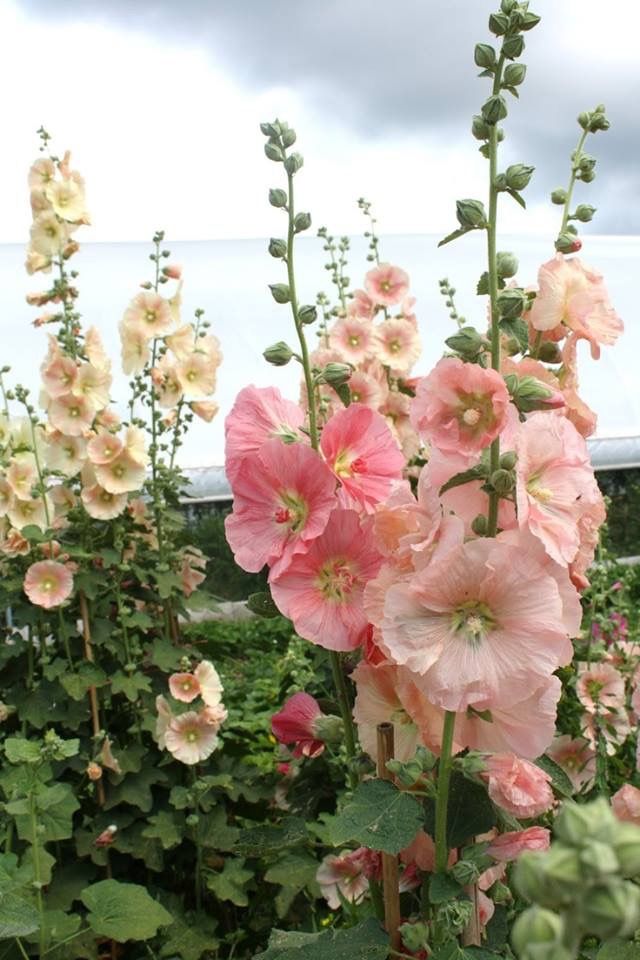 If the bushes are in partial shade, they will turn out to be low, they will bloom, but not as actively as in an open flower bed.
If the bushes are in partial shade, they will turn out to be low, they will bloom, but not as actively as in an open flower bed.
Sowing mallow seeds in autumn
Attention! Before you start sowing stock-rose seeds in the fall, the soil is prepared in advance.
The flower bed is dug up to a full bayonet, the roots of weeds are selected. If the soil is infertile, fertilize it with peat, rotted compost or humus before sowing.
How to properly plant a mallow flower in autumn:
- At a distance of 40-50 cm from each other, make holes 2.5-3 cm deep.
- Several seeds are sown in each hole, sprinkled with soil, mulched for the winter with peat or dry leaves.
- Autumn crops of bluebell are not watered, at this time of the year there is a lot of rain.
In the spring, when the weather is consistently warm, shoots will appear.
Aftercare
Cultivation of bun bushes is easy. Mandatory requirements for cultivation are moderate watering, regular loosening of the soil and timely removal of faded flower stalks.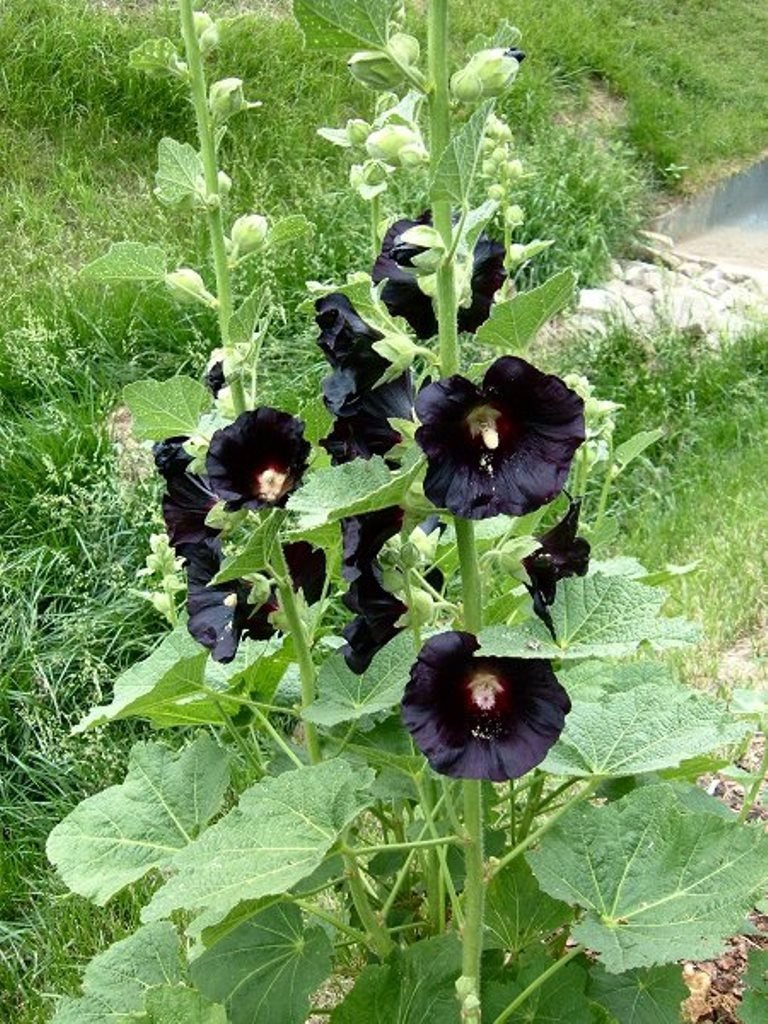
Watering is carried out if there has been no precipitation for two weeks. In other cases, the plant extracts water from the soil on its own, with the help of a long rhizome.
In order to provide the root system of stock roses with oxygen, loosening is recommended after each rainfall or watering.Before the crop throws out buds, it should be fed with mineral fertilizers. To ensure abundant flowering of mallow, flower stalks are removed immediately, as soon as they have faded, preventing seeds from setting.
If the bushes do not grow along the fence, then a support should be placed next to the tall plant, as it can break under gusts of wind.
Experienced gardeners do not recommend transplanting shrubs to another place. Culture does not tolerate this procedure.
Diseases and pests
Mallow is quite resistant to diseases, but if agrotechnical standards are violated, it is also prone to diseases. The most dangerous for mallow are:
- Rust - appears on the reverse side of the sheet plates with light brown spots.
 Often, infection occurs from metal fences, next to which a small ball is planted. The plant is inspected, the affected leaves are removed and disposed of outside the site.
Often, infection occurs from metal fences, next to which a small ball is planted. The plant is inspected, the affected leaves are removed and disposed of outside the site. - Powdery mildew is a fungal disease that manifests itself as a whitish coating on the leaf plates of the culture. You can cope with it only with the help of specialized fungicides.
Attention! Of the pests, slugs are dangerous for mallow. They are collected by hand, placed on the way to the beds of the trap.
How to keep mallow in the ground in winter
Mallow is a frost-resistant plant. In order to preserve young shrubs in winter, in the fall, without fail, they are mulched with peat or rotted leaves, covered with spruce branches on top.
Shrubs that are more than 2 years old do not need to be covered for the winter. If the area is open, blown by drafts, it is better not to risk it. It is better to sprinkle the underground part of the kalachik with dry foliage.